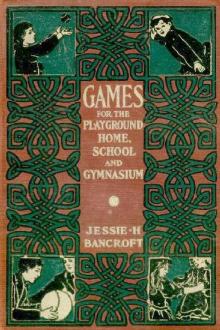Games for the Playground, Home, School and Gymnasium by Jessie Hubbell Bancroft (top novels of all time .txt) 📕

- Author: Jessie Hubbell Bancroft
- Performer: -
Book online «Games for the Playground, Home, School and Gymnasium by Jessie Hubbell Bancroft (top novels of all time .txt) 📕». Author Jessie Hubbell Bancroft
10 to 60 players.
Schoolroom.
The class is divided into two equal divisions or teams. The teams stand in opposite outside aisles and face the center of the room. The game consists in a contest between the two divisions as to which shall finish first in the following relay, here described for one team.
The leader at the head or front of the line, having the bean bag in his hand, runs down the first aisle toward the rear, places the bean bag on the center seat of the row to his left (second row from standing line), vaults over the seat, and runs up the next aisle to the front of the room and so to the head of his division. He tags the player standing at the head of the line and passes behind the line to the rear, taking his place at the foot.
The player who has been tagged at the head of the line immediately runs down the first aisle, takes the bean bag from the seat, vaults over the seat, and passes down the next aisle to the rear of the room, and so to the foot of his line. He hands the bean bag to the player next to him, who passes it to his neighbor, and so it is passed up to the head of the line.
The player at the head of the line, immediately upon receiving the bean bag, runs down the first aisle, places it on the seat, vaults over the seat to the next aisle, and so to the head of his line, where he tags the player who has moved up to his place.
The game thus consists in an alternate placing and taking of the bag from the seat. The player who places the bag returns to the head of the line to tag the player standing there, and then passes behind the line to the foot; the player taking the bean bag returns to the rear of his line and passes the bean bag up the line.
The division whose original leader first gets back to his starting place wins the game.
This game was originated by Miss Alice R. Young of Brooklyn, N.Y., and received honorable mention in a competition for schoolroom games conducted by the Girls' Branch of the Public Schools Athletic League of New York City in 1906. It is here published by the kind permission of the author, and of the Girls' Branch, and of Messrs. A. G. Spalding & Brothers, publishers of the handbook in which the game first appeared.
PASSING RELAYSThere are several forms of this game, some of which are suited only to young children; others may be full of sport and interest for adults. The games may be adapted to comparatively small numbers or very large numbers. Several passing races will be found among the ball games. For bean bags, see:—
Passing Race.
Pass and Toss Relay (single line).
Pass and Toss Relay (double line).
PASSING RACE
10 to 100 players.
Playground; gymnasium; schoolroom.
Bean bags; dumb-bells.
The players stand in ranks, and bags are passed from one to another player down each line, starting on a signal for the first bag. Each rank should have about ten bags. The line wins which finishes first; that is, passes all of its bags to the end of the line.
The game may be varied by having each player pass the bags from one hand to the other before handing it to his neighbor, or by raising the bags overhead, or touching them to the floor, first with one hand, then with the other, before passing.
This makes an especially interesting game when dumb-bells are used instead of bean bags, as they are harder to pass.
PASS AND TOSS RELAY (SINGLE LINE)16 to 60 players.
Gymnasium; playground; schoolroom.
Bean bags; oat sacks.
The players stand in two or more even ranks, facing sideways. The players at either end step one long pace forward of the ranks, to the points marked 1 and 10 respectively, as they are to catch the bag tossed from some other player. Player Number One has a bag and at the signal for starting runs toward the rear, and as he runs tosses the bag to Number Ten. The line immediately moves forward one place, Number Two stepping into the place vacated by Number One. As soon as Number Ten has caught the bag, he takes his place in line with the rank and passes the bag to his next neighbor, Number Nine. The bag is then passed rapidly up the line until it is received by Number Three, who tosses it to Number Two. Number Two, in his turn, as soon as he receives the bag, dashes for the rear, tossing the bag as he goes to the player standing at 10, who in this instance will be Number One. The line again moves up, Number Three now stepping out to the place marked 1.
This play is continued until Number One is back in his original position. The rank which first gets the bag around to Number One after he returns to his original position wins the game. Number One should hold the bag up at arm's length as soon as he gets it as a signal that his rank has completed its play. As this feature adds much to the facility with which an umpire may judge of the winning rank, it may well be a required part of the play, the rank winning whose Number One is first to raise aloft his bag.
It adds much to the interest of the game to have a general umpire and scorekeeper who shall decide which is the winning line, and post the score where the players may see it.
PASS AND TOSS RELAY (DOUBLE LINE)16 to 60 players.
Playground; gymnasium; schoolroom.
Bean bags; oat sacks.
The players are divided into two equal groups which compete against each other. Each group is divided into two lines or ranks which stand facing each other. There should be from ten to twenty feet of space between the two ranks.
The game consists of passing a bean bag up one of these lines to the end, when the last player runs across to the opposite line, tossing the bag as he goes to the end man in that line, who catches it and passes it down the line. The same play is performed at the other end, the last player running across to the opposite line, tossing the bag as he goes to the last player there. The lines move up or down one place each time a player runs across to the opposite rank. The game in detail will be as follows:—
Number One has a bag, and at a signal passes it down the line to Number Eight, who runs across toward Number Nine, tossing the bag to Number Nine as he does so. It must be tossed before he has gone halfway across the space between. Number Nine immediately passes the bag to Number Ten, and so on up the line to the last player, Number Sixteen. The moment that he receives the bag, he runs across toward Number One in the opposite rank, making a running toss as he does so. At the same time the entire line from Nine to Fifteen moves up one place to make room for Number Eight, who should take his place at the foot of the line next to Number Nine. As soon as Number One receives the bag, he passes it down the line to his neighbor, Number Two, and so on till it reaches the end of the line, which at the same time should be moving down one place to make room for Number Sixteen, who should take his place at the head of the line next beyond Number One.
This play is repeated until Number One reaches his original position again, and the bag is passed to him there. Immediately on receiving it, he should lift it high, as a signal that the play is completed in his group. The group wins whose first player is first to do this.
The game may be made a little more definite by Number One having some distinguishing mark, as a handkerchief, tied on his arm.
When players have some proficiency in the game, as prescribed, they may play with two bags instead of one, keeping both in play at once. In this form of the game the diagonal opposites start each a bag at the same time, that is, Number One and Number Nine. The game becomes thus just twice as rapid. The team wins whose Numbers One and Nine first succeed in both returning to their original positions, where they should hold the bags aloft.
A score should be kept, each team scoring two points for winning a game and one point for every time that its opponents' bags touch the floor, either through poor throwing or bad catching.
The writer is indebted to Mr. Chesley's Indoor and Outdoor Gymnastic Games for several points of description or of play for this game. Mr. Chesley has found it a very interesting gymnasium game, with possibilities for much sport and skill.
TARGET TOSS10 to 60 players.
Playground; seashore; gymnasium; schoolroom.
Bean bags; stones; shells.
Three concentric circles should be drawn on the ground or floor, after the idea of a target. Their size will depend somewhat on the skill of the players, but for the youngest players the inner circle should be not more than two feet in diameter and the outer circle six feet in diameter. For those more skilled, smaller circles may be used. From ten to thirty feet from the outer rim of the largest circle a straight line is drawn on the ground, to serve as a throwing line. Where there is a small number of players, all may use one target. Where there is a large number, several targets should be drawn and the players divided into as many groups. Each group has three bean bags, or if out of doors, small blocks of wood, stones, or shells may be used. Each player throws in turn, throwing each of the three bags or other objects at each turn. The thrower stands with his toe on the throwing line and tosses a bag toward the target. If the bag stops within the center circle, it scores fifteen points; if between the center circle and the next larger one, it scores ten points; and if between the middle circle and the largest or outer one, it scores five points. For very little children a bag that lands on a line may score for the larger circle which it touches. For more expert players, a bag landing on a line does not score at all. The player wins who has the highest score in five rounds of the game.
TEACHER AND CLASS5 to 60 players.
Playground; gymnasium; class room.
Bean bags; balls.
This game may be played with either bean bags or balls, and is one of the simplest and earliest tossing games, being generally used when pupils are first acquiring skill in handling a ball. With very rapid play and greater distance between the "teacher" and the "class," it may become very interesting, however, for older players.
One player is chosen for the "teacher." The others stand in a line side by side, facing her, at an interval of from five to twenty feet. Where there are many players, there should be several groups of this kind, with





Comments (0)